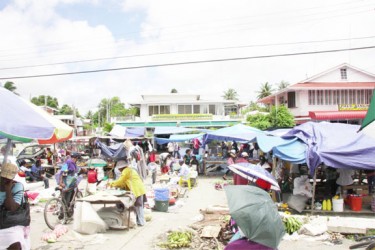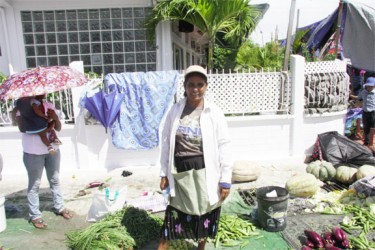Port Mourant boasts one of those local markets that is a mix of commerce and spectacle. Every Saturday, throngs congregate there, to vend, to ‘snap up’ bargains, or else, to simply ‘soak up’ the environment. Stabroek Business was there two weekends ago.
We knew that we had arrived in the general area of the market when the traffic in both directions slowed to a crawl. The lone policeman who had been assigned to bring some semblance of order to the traffic appeared decidedly overwhelmed. We asked a taxi driver to tell us about the market. Once he had ascertained that we were medi
a he wanted, instead, to bellyache about the fact that a section of the tarmac designated for taxis had been taken over by vendors. He told us that no one else in authority was listening. Frankly, in the circumstances, the vendor takeover of the tarmac was not our principal interest either.
The Saturday Port Mourant Market can, in some respects, be compared with the Monday Charity Market. Wherever else you do business on the Essequibo Coast during the rest of the week, you trade at Charity on Mondays. It is the same on Saturdays at Port Mourant. It seems that everyone from up and down the coast and not a few from this side of the Berbice River find their way to Port Mourant.

You put your money together, dress yourself, get into the spirit of things and find yourself at Port Mourant.
It is the bargains, mostly, that take people there… vegetables, meat, fish, ground provision, creole chicken, plucked chicken and fruit. There are, too, offerings of jewellery, clothing, handbags and ladies’ accessories. This particular Saturday, Berbicians appeared to be in the mood to spend.
We were unable to determine exactly when the Port Mourant Market was first built though a Mr. Permaul, who sits on the Neighbourhood Democratic Council told us that it was rebuilt in 2010. The Market houses 700 stalls plus the additional 300 or so that vend on the ground, both inside the market and out onto the roadway.
We met a group of high-spirited shoppers who boasted that Port Mourant Market was the cheapest market in Berbice. “On a good day,” one of them told us, you could spend two thousand dollars and “go home with” enough fruit and vegetables to feed a family of about five for a week!
The people appeared unmindful of the fact that we were strangers. They were talkative. One housewife told us that she comes to the market every Saturday. She gets there around 5:30 hrs and tries to conclude her business before the heat of the day kicks in. More than that, she told us that the earlier you get to the market, the better the “bargains.”
At one point we observed the vendors from the less congested vantage point of a perpetually busy business establishment called Spready’s Snackette & Bakery. They were in a haste to ‘sell out’ and appeared to have immersed themselves in what appeared to be a somewhat reckless exercise in giving away bargains. They were offering mostly vegetables and there was no shortage of bargain-hunters.
By 11:00 hrs Port Mourant Market slows to a crawl. It is simply too hot to trade outdoors. That’s when prices go down, momentarily, then the trading stops.
Some of the vendors would have arrived at the market as early as 23:00 hrs on the previous night – from West Coast Berbice, Crabwood Creek and Black Bush Polder. By 09:00 hrs they had already “sold out” and were packing up to leave.
We learnt a few things about the hours of trading. Early departure was partly a function of the extent to which particular consumer items are in demand. The “good days” also have to do with whether or not there is activity on the sugar estates. Sugar is one of those commodities around which employment and the economy of Berbice evolves. At Port Mourant there is a sense of worry about the difficulties facing the sugar industry.
Sita is a ‘Rose Hall girl,’ a fifty-three-year-old vegetable vendor. The trading spot she occupies is an inheritance from her mother. As a girl, more than forty years ago, she had traded on that very spot beside her mother. Her own current assistant is a daughter-in-law. She boasts that she was able to educate and “marry” her children with her earnings from vending. Sita trades every day, from Monday to Friday and Sundays at Rose Hall and on Saturdays at Port Mourant.
We began to observe the trading more closely. We counted around fourteen ochro being offered for one hundred dollars. A few more were being thrown in as ‘mek up.’ We were told that vegetable prices were expected to remain “stable” for the next few weeks but there was no telling what would happen beyond that period. Over the last month between four and five boulangers were being offered for one hundred dollars.

Women are the backbone of an agricultural pursuit known as backyard farming in Berbice. The spaces which they cultivate are much larger than those spaces known as kitchen gardens. Most of these farming ventures subsidize some other form of family employment.
Our recent travels to some farming communities have led to the discovery that pepper is ‘in season.’ It is the same at Port Mourant Market. On the Saturday when we were there pepper was being sold at one hundred dollars a pint. It appeared that pepper sauce manufacturers were taking advantage of the glut. There has always been a brisk demand for pepper sauce among relatives and friends in the diaspora. Most of it is fetched abroad in suitcases.
When we were at Port Mourant you could buy seven oranges for two hundred dollars; eschallot was priced at one hundred or one hundred and sixty dollars per pound and seime at two hundred dollars per pound. You could get a reasonably sized squash for one hundred dollars, (squash is particularly popular with Berbice households) while shoppers were purchasing four tangerines for one hundred dollars.
At a price range of between two hundred and three hundred dollars pineapples were considered “pricey.’ Both mango and genip were plentiful. Only a handful of vendors were trading in ground provision though you could still buy three pounds of cassava for two hundred dollars and eddo for as little as sixty dollars per pound.
Much of the ground provision is cultivated in Crabwood Creek. We spoke with a vendor who plants four acres of ground provision and plantains. Not surprisingly, she was trading at prices that were below what appeared to be the fixed prices on that particular day.
The eastern extreme of the market is awash with live birds. Chicken remains the meat of choice but consumers were also buying turkeys and ducks. We asked about duck prices. Two modest sized ones were being sold for three thousand dollars.
Shawn rears poultry. He was offering a pair of hens for one thousand dollars and Rhode Island fowl cocks for between fifteen hundred and two thousand dollars a pair. Consumers also go to the market looking for creole ducks and chickens to boost their own farmyards.
Berbice is ‘fish country.’ The fishmongers in the market were advertising their bargains aggressively. “Black shrimp” and ‘Bangamary” appeared to be attracting the most attention among the buyers.
Fish comes in considerable variety. Outside of the conventional varieties – snapper, trout, et al – there are those that are known by strange-sounding given names. As best as we could tell seafood is popular with Berbicians, a fact that we did not find surprising. Consumer tastes in fish vary widely from one species to another.
One variety, pronounced Seamongul (no one seems to be certain of the accurate spellings for those fish with the odder names) appeared to be the most popular amongst consumers.
You could get up to three Seamongul for five hundred dollars. Of the other varieties we noted that Cuirass was being sold ‘by the slice’… five hundred dollars per slice. Snapper was being offered at the same price.
The range of seafood went beyond the conventional. Consumers were ‘snapping up’ around forty small sardine-like fish for two hundred dollars. Peeled and unpeeled sea shrimp were also on offer.
The better-known species were also in evidence. Cuffum was ‘going for’ a thousand dollar a slice and Hassar was being traded at around 25 thousand dollars per bucket.
Data is a cane-cutter who sells fish when there is no cane to cut. She trades mostly in sweet water fish. Today, however, hassar is scarce and she is offering shrimp acquired from a wholesaler in Black Bush Polder. The travails of GuySuCo have caused Data to hedge her bets.
Harrichan Samaroo is a more established businessman. He owns a fishing boat and has been selling his own catch. By the time we got to his stall he was ‘sold out.’ He had had a good trading day, however, and was only too happy to talk with us about fishing on the whole. He employs three workers. They spend up to three or four days “on the water,” their fishing trips carefully timed to ensure their return for the Saturday market. Sometimes his employees make the fishing trip alone.
He talks about river piracy too. He has been robbed of his engines, his catch, and his nets among others. He explains that taking cell phones on fishing trips can be risky. It’s the first thing that the pirates ask for and if a search of the boat comes up with a cell phone after you have told the pirates that there is none on board, there is a good chance that they might injure or even kill the occupants of the fishing vessel.
Berbice fishermen want piracy to go away but they have become philosophical about the phenomenon. As far as Harrichan is concerned, fishing is his way of making a living and the pirates will not make him quit. He concedes, though, that the pirates have made him mindful of the dangers. While a cell phone can be useful on the water he leaves his at home.
You get a sense that Port Mourant Market is indeed one of those landmark institutions in Berbice. It is reflective of a thriving commercial culture that is alive and well. You come away with an enhanced respect for both the farmers and the traders and it crosses your mind that food security is not one of those weaknesses that we need worry unduly about.





